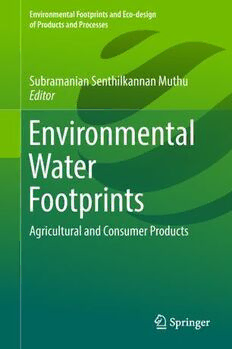
Environmental Water Footprints: Agricultural and Consumer Products PDF
Preview Environmental Water Footprints: Agricultural and Consumer Products
Environmental Footprints and Eco-design of Products and Processes Subramanian Senthilkannan Muthu Editor Environmental Water Footprints Agricultural and Consumer Products Environmental Footprints and Eco-design of Products and Processes Series editor Subramanian Senthilkannan Muthu, SgT Group and API, Hong Kong, Hong Kong Thisseriesaimstobroadlycoveralltheaspectsrelatedtoenvironmentalassessment ofproducts,developmentofenvironmentalandecologicalindicatorsandeco-design ofvariousproductsandprocesses.Belowaretheareasfallundertheaimsandscope ofthisseries,butnotlimitedto:EnvironmentalLifeCycleAssessment;SocialLife Cycle Assessment; Organizational and Product Carbon Footprints; Ecological, Energy and Water Footprints; Life cycle costing; Environmental and sustainable indicators; Environmental impact assessment methods and tools; Eco-design (sustainable design) aspects and tools; Biodegradation studies; Recycling; Solid waste management; Environmental and social audits; Green Purchasing and tools; Product environmental footprints; Environmental management standards and regulations; Eco-labels; Green Claims and green washing; Assessment of sustain- ability aspects. More information about this series at http://www.springer.com/series/13340 Subramanian Senthilkannan Muthu Editor Environmental Water Footprints Agricultural and Consumer Products 123 Editor Subramanian SenthilkannanMuthu SgT GroupandAPI Hong Kong,Kowloon Hong Kong ISSN 2345-7651 ISSN 2345-766X (electronic) Environmental Footprints andEco-design of ProductsandProcesses ISBN978-981-13-2507-6 ISBN978-981-13-2508-3 (eBook) https://doi.org/10.1007/978-981-13-2508-3 LibraryofCongressControlNumber:2018953647 ©SpringerNatureSingaporePteLtd.2019 Thisworkissubjecttocopyright.AllrightsarereservedbythePublisher,whetherthewholeorpart of the material is concerned, specifically the rights of translation, reprinting, reuse of illustrations, recitation, broadcasting, reproduction on microfilms or in any other physical way, and transmission orinformationstorageandretrieval,electronicadaptation,computersoftware,orbysimilarordissimilar methodologynowknownorhereafterdeveloped. The use of general descriptive names, registered names, trademarks, service marks, etc. in this publicationdoesnotimply,evenintheabsenceofaspecificstatement,thatsuchnamesareexemptfrom therelevantprotectivelawsandregulationsandthereforefreeforgeneraluse. The publisher, the authors and the editors are safe to assume that the advice and information in this book are believed to be true and accurate at the date of publication. Neither the publisher nor the authorsortheeditorsgiveawarranty,expressorimplied,withrespecttothematerialcontainedhereinor for any errors or omissions that may have been made. The publisher remains neutral with regard to jurisdictionalclaimsinpublishedmapsandinstitutionalaffiliations. ThisSpringerimprintispublishedbytheregisteredcompanySpringerNatureSingaporePteLtd. Theregisteredcompanyaddressis:152BeachRoad,#21-01/04GatewayEast,Singapore189721, Singapore This book is dedicated to: The lotus feet of my beloved Lord Pazhaniandavar My beloved late Father My beloved Mother My beloved Wife Karpagam and Daughters—Anu and Karthika My beloved Brother Everyone working in the Agricultural and Consumer Products sectors to make it ENVIRONMENTALLY SUSTAINABLE Contents Water Footprint of Agricultural Products . . . . . . . . . . . . . . . . . . . . . . . 1 P. Senthil Kumar and G. Janet Joshiba Water Footprint of Livestock Farming. . . . . . . . . . . . . . . . . . . . . . . . . . 21 I. Noya, L. Lijo, O. Piñeiro, R. Lopez-Carracelas, B. Omil, M. T. Barral, A. Merino, G. Feijoo and M. T. Moreira Water Footprint and Consumer Products . . . . . . . . . . . . . . . . . . . . . . . 55 Ignacio Cazcarro and Iñaki Arto Water Footprint of a Decentralised Wastewater Treatment Strategy Based on Membrane Technology . . . . . . . . . . . . . . . . . . . . . . . 85 A. Arias, I. Vallina, Y. Lorenzo, O. T. Komesli, E. Katsou, G. Feijoo and M. T. Moreira vii Water Footprint of Agricultural Products P.SenthilKumarandG.JanetJoshiba Abstract Water is a greatest gift of nature and it is an essential necessity of all livingorganismtosurviveinearth.Duetotheoverexposureofindustrializationand urbanizationthequantityandthequalityofthewatersourcesaregettingdepleted, thusitisnecessarytomeasurethevolumeofthewaterconsumedtocreateeachof the merchandise and enterprises we utilize. The water foot printing helps people, organizationsandnationsbydisclosingtheamountofwaterutilizedbyallsectors fromanindividualleveltonationallevel.Theyalsohelpinhighlightingthevolume of water utilized as a part of the considerable number of procedures engaged with assemblinganddeliveringourproducts.Theylikewiserepresentthemeasureofwater defiledamidassemblingandgeneration.Agricultureisoneofthemajorconsumers of water and it fully depends on water for growth and production of agricultural products.Itisdirectlyandindirectlylinkedwiththewaterscarcity,Furthermoreit is also one of the major sources affecting the quality of water by overloading the freshwaterwithexcessamountofnutrients.Foodproductionisdirectlylinkedwith thewaterscarcityandsotoincreasethefoodproduction itisessentialtomeasure thewaterutilityinagriculturalprocess.Waterfootprintofagriculturalproductsaims in developing new strategies to overcome the water scarcity in agricultural sector andithelpsinadministeringmanyeffectiverulesforempoweringamoreproficient governanceofwatersourcesunderclimaticchanges,industrialpollutionandvarious otherfactorsaffectingthequalityofwater.Thisreviewnarratesthevariousfeatures ofthewaterfootprintintheagriculturalproducts. · · · Keywords Waterfootprint Waterscarcity Foodproduction Agriculture B P.SenthilKumar( )·G.JanetJoshiba DepartmentofChemicalEngineering,SSNCollegeofEngineering, Chennai603110,India e-mail:[email protected];[email protected] ©SpringerNatureSingaporePteLtd.2019 1 S.S.Muthu(ed.),EnvironmentalWaterFootprints,EnvironmentalFootprints andEco-designofProductsandProcesses, https://doi.org/10.1007/978-981-13-2508-3_1 2 P.SenthilKumarandG.JanetJoshiba 1 Introduction WaterisoneofthegreatestgiftsofMotherNature.Lifewithoutwaterisunimagin- ableinearth.Waterisanessentialsourceforenergyandeverylivingbeinginearth dependsonwaterforenergy.Nowadays,duetohighpopulationgrowth,advancement ineconomy,industrialgrowth,changingclimaticconditions,etc.,causesdepletion offreshwatersources(Hogeboometal.2018).Withtheexplosionofpopulationout- growthcombinedwithchangingeatingregimeninclinations,waterwithdrawalsare reliedupontokeeponincreasinginthecomingdecadesuniversally,thewaterscarcity hasexpandedaboutsevenfoldinthepreviouscentury.Evenaftertheimplementation ofwastewatertreatmentintheindustries,theusedwatercannotberegainedforother purposebecauseoftheunpredictableglobalwarming,ozonedepletionandclimatic changeswhicharecausingevaporationofwatersources.Furthermore,around85% ofglobalwaterisutilizedforfarmingpurposes(MekonnenandHoekstra2011).The developingassemblageofresearchonwaterutilize,shortageandcontaminationin connection to utilization, generation and exchange has prompted the development ofthefieldofWaterFootprint(Hoekstra2017).Thewaterfootprintingofitemsis generally used by the private organisations to perform chance evaluation and it is used as an instrument to distinguish hotspots in their supply affixes or to couple it with instruments like LCA techniques keeping in mind the end goal to perform benchmarking of items. In the second case, it is used to provide the fundamental data of the occupants of a particular nation who are consuming the water sources and it is used by the scholarly community, Non-Governmental Organisations and private sectors (UNEP 2011). Agriculture is the largest global consumer of fresh watersources.Theriskofdepletionofglobalfreshwatersourcesincreasesdueto theoutgrowthofinevitableenvironmentalissuescausingdepletionofwatersources globallyleadingtodeficiencyoffreshwatersourcesforagriculturalconsumption. The water utilization for crop production is getting elevated every year by 0.7% andtherequirementofwaterforcropproductionwillincreasefromalevelof6400 Gm3/yrto9060Gm3/yrbytheyear2050tonourisharound9.2billionoftheglobal population(MekonnenandHoekstra2013).Groundwaterisabestsourceoffresh water which meets the requirements of billions of people and it plays an extraor- dinary role in the agriculture which remains as the basic food production source of human beings. The ground water level is evaluated by many governmental and non-governmentalorganizationstoknowabouttherateofdepletionofgroundwater duetosomeenvironmentalissues(Gleesonetal.2012).Wateractsasanoutstanding resourceofnatureanditplaceaphenomenalroleinthedevelopmentofmerchandise andenterprises,furthermore,thewaterutilizedasapartofthemanufacturingsector isknownasthevirtualwater.Formanufacturing1kgofgrainweneedapproximately 1000–2000kgofwater.Fordelivering1kgofmeatwerequireinnormal16000kg ofwater,whereasforproducing1kgofcheddarwerequireabout5000–5500kgof water.Everyitemmanufacturedinanindustrialsectorcompulsorilyneedswateras amainrawmaterial(Hoekstra2003).Variouswaterconsumingactivitiesfollowed globallyaredepictedinthe(Fig.1).Thedevelopingfreshwatershortageisasofnow WaterFootprintofAgriculturalProducts 3 Fig.1 Variouswaterconsumingactivities apparentinnumerouspartsoftheworld.Raisingwaterscarcityincreasestheriskfor deficiencyoffreshwatersourcesforagriculturalutilizationwhichleadstodepletion infoodproduction.Thewaterfootprintoffersaquantifiablemarkertoquantifythe volumeofwaterutilizationperunitofharvest,andinadditionthevolumeofwater contamination(MekonnenandHoekstra2013).Thisarticleelucidatetheimpactof agricultureontheglobalwatersourcesanditgivesancleardescriptionofthewater footprintingconcepts,itsmethodology,datacollectionmethodanditalsoexplains theimportanceofwaterfootprintingontheagriculturalproductsanditsimpacton developingtheglobalfreshwatersources. 2 GlobalDemandforWater 2.1 WaterFootprintConcept The water footprint concept was enunciated in an international expert meeting on virtualwatertradeintheyear2002,December.HoekstraandHunghaveenunciated theideaofthewaterfootprintingtoknowaboutthisoverallamountofvirtualwater substanceofallmerchandiseandenterprisesdevouredbyoneindividualorbythe peopleofonenation.Whencomparedwiththeotherresourcessuchasland,airand energy,onlylittleresearchhasbeendoneinthewateranditsimpactonitsutilization byindustriesformanufacturinggoodsandservices(Hoekstra2003).Thewaterfoot- printingmeasuresthequantityofwaterusedinmanufacturingaproductintoevery one of the merchandise and enterprises globally and it also likewise reveals about the amount of water being devoured by every nation globally (Water footprinting network). They presented the water footprint as a marker for utilization of water
